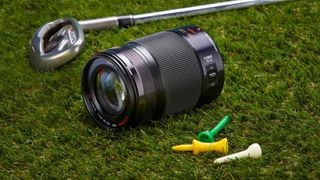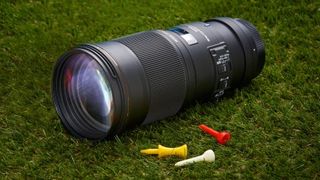Best mid-price telephoto lenses
We round up eight DSLR and CSC telephotos that combine performance and value
Canon EF 70-200mm f/4L IS USM
• Canon EF 70-200mm f/4L IS USM review
Canon's 70-200mm is relatively slim but still has a constant f/4 maximum aperture. Like many of Canon's L-series (luxury) lenses, this one is finished in cream or off-white, rather than the usual black. The idea is that the outer surface reflects more light, and therefore incurs less heat build-up when used in bright sunlight for long periods of time.

Like most other Canon L-series lenses, it has a weather-sealed construction, which is lacking in the non-stabilized edition of the EF 70-200mm f/4L USM. It can be used on both full frame Canon DSLRs and APS-C format models (where the equivalent focal length is 112-320mm.
Nikon AF-S 70-200mm f/4G ED VR
• Nikon AF-S 70-200mm f/4G ED VR review
This Nikon 70-200mm f/4 only gives away 1 stop in maximum aperture to Nikon's legendary 70-200mm pro lens, but it's both lighter and cheaper. It can be used on full-frame (FX format) Nikons as well as APS-C (DX format) models, where the effective focal length is 105-300mm.

It's well made, with a weather-sealed mounting plate and a switch for AM/M focussing – the AM mode enables autofocus with full-time manual override. There's also a focus limiter, which locks out autofocus distances shorter than 3m, and two Vibration Reduction switches – on/off and normal/active. It has auto-detection for panning, and the active mode is designed for shooting from a vibrating platform.
Panasonic G X 35-100mm f/2.8 Power OIS
• Panasonic G X 35-100mm f/2.8 Power OIS review
Get daily insight, inspiration and deals in your inbox
Get the hottest deals available in your inbox plus news, reviews, opinion, analysis and more from the TechRadar team.
This is a fast and powerful telephoto for Micro Four Thirds cameras. The fact that Micro Four Thirds sensors are slightly smaller than APS-C means that fast, constant aperture lenses like this are smaller and lighter than their DSLR equivalents.

The smaller sensor also gives this lens a longer reach – the effective focal range is actually 70-200mm, so it's a direct equivalent to the 70-200mm f/2.8 pro lenses on full-frame DSLRs. Build quality feels solid and includes dust and splash resistance, while the stepping motor autofocus system is typically silent.
Pentax DA* 200mm f/2.8 ED IF SDM
• Pentax DA* 200mm f/2.8 ED IF SDM review
Pentax's 200mm f/2.8 prime lens has pros and cons. Prime lenses aren't as flexible as zooms, obviously, but they do typically offer faster maximum apertures and should bring better image quality. Pentax only makes APS-C format cameras, so this effectively becomes a 300mm f/2.8 lens on a Pentax DSLR. It's slightly shorter than most 70-200mm f/4 zoom lenses, but roughly the same weight, despite being a full f-stop faster.

This lens's upmarket build quality includes weather seals and a robust and rugged feel, along with a dirt-resistant coating on the front element. Other attractions in this lens include Extra-low Dispersion glass, internal focusing and ring-type ultrasonic autofocus.
Sigma APO 70-200mm f/2.8 EX DG OS HSM
• Sigma APO 70-200mm f/2.8 EX DG OS HSM review
Sigma's fixed-aperture mid-range zoom is a long-standing favourite, and it can be used on both full-frame cameras and APS-C format D-SLRs – on APS-C cameras the focal range effectively becomes 105-300mm. The Sigma shows that third-party lenses aren't always the poor relations – the best can give more features and more performance for your money.

The Sigma is under half the price of the Nikon and £1,200 less than the Canon equivalents. Inside the lens are two FLD (F Low Dispersion) elements, claimed to equal top-quality fluorite glass in performance, as well as three SLD (Special Low Dispersion) elements, plus Super Multi-Layer Coatings. The aim is for excellent sharpness and contrast, with minimal color fringing, ghosting and flare.
Sigma APO Macro 180mm f/2.8 EX DG OS HSM
• Sigma APO Macro 180mm f/2.8 EX DG OS HSM review
This Sigma prime lens is designed for macro photography, but its focal length and wide maximum aperture make it an excellent telephoto lens too. The 180mm focal length and f/2.8 maximum aperture are ideal for low-light sports/action photography as well as tight close-ups. It can be used on both full-frame cameras and APS-C models, where the smaller sensor size means it effectively becomes a 270mm f/2.8.

Like most macro lenses, the Sigma has a long travel distance in its manual focus ring to enable precise close-up focussing. It's surprising, then, that the autofocus is so fast, snapping into focus even over large changes in distance. There's a three-position focus limiter switch, for locking the autofocus range to either end or enabling full travel.
Sony FE 70-200mm f/4 G OSS
• Sony FE 70-200mm f/4 G OSS review
This is a high-spec telephoto zoom designed for the full-frame Sony Alpha A7 range. Sony needs to keep rolling out new lenses to boost the appeal of its full-frame compact system cameras, so this is a welcome addition. While A7 cameras are slim compared with SLRs, there's nothing small about this lens. It's every bit as big and heavy as similar lenses for full-frame DSLRs, weighing in at 840g.

The Sony is dust and water-resistant but lacks the weather-sealed mounting plate of many competing lenses. There's a set of switches for AF/M focussing, an autofocus range limiter, on/off for the optical stabilizer, and mode 1/2 for static or panning stabilization. The Sony also has a similar off-white paint job to Canon's pro telephoto lenses.
Tamron SP 70-200mm f/2.8 Di VC USD
• Tamron SP 70-200mm f/2.8 Di VC USD review
The Tamron SP 70-200mm f/2.8 proves you don't have to go for a maker's own lenses to get top-quality performance. It's designed to work on both full-frame DSLRs and APS-C format cameras, where the focal length is equivalent to 105-300mm. The 'SP' denotes one of Tamron's 'Super Performance' lenses, and it joins another of our favorites, the Tamron SP 24-70mm f/2.8 Di VC USD.

The 70-200mm has a truly professional feel with weather seals, fast ring-type ultrasonic autofocus and Tamron's proprietary Vibration Compensation optical stabilizer (though the stabilizer is omitted from the Sony version).
